Coolest New Style Steel Rolex Watch

While gold and platinum Rolex watches are available, the Luxury Steel Rolex Watches are the brand’s most popular. They are sets of timepieces with astonishing designs. They are generally more modest, robust, and athletic than their precious metal cousins, in addition to being less expensive. As a result, waitlists for stainless steel models can be significantly longer than those for gold ones.
We look at the best Luxury Steel Rolex Watches from both the sports watch and the dress watch categories below. Let’s take a deeper look at the various Rolex stainless steel heavyweights.
The Coolest Luxury Steel Rolex Watch in no Particular Order
Rolex Oyster Perpetual
This Luxury Steel Rolex Watch, which debuted in 1926, is the world’s first fully waterproof watch. Rolex also introduced the self-winding perpetual mechanism in 1931. The movement includes a “Perpetual” rotor, which swings with the wearer’s natural wrist motions to wind up the mainspring. The waterproof casing and automatic movement will later become the features of the vast majority of Luxury Steel Rolex Watches. Most Rolex watches, including the DateJust, Submariner, and Daytona, fall under the Oyster Perpetual category. But this is not the same as the Oyster Perpetual watch type.

Rolex Submariner
This Luxury Steel Rolex Watch is unquestionably the world’s most renowned luxury dive watch. Designed its debut in 1953 as the first dive watch certified to a depth of 100 meters. Rolex designed the Submariner specifically for scuba divers. It has a rotating bezel marked to 60 minutes to measure immersion durations. A time-only display with luminous hands and hour markings, and stainless steel construction for corrosion protection. In the late 1960s, Rolex expanded the range with Submariner models that had date windows. Furthermore, in addition to steel Submariner Date versions, Rolex eventually expanded the line. This includes full gold and two-tone Submariner watches.
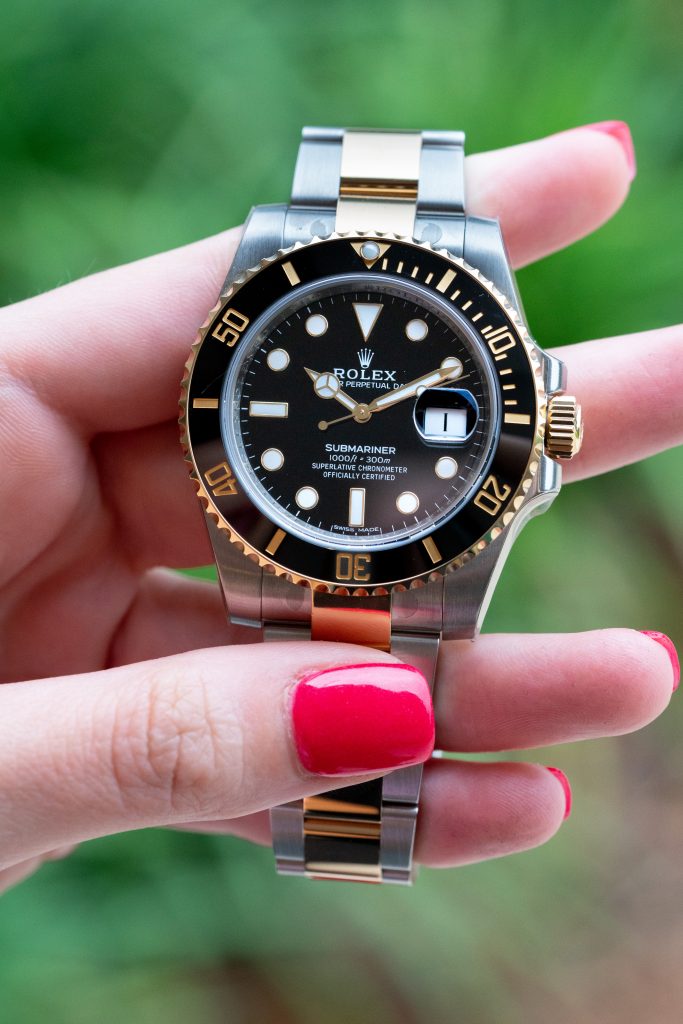
Naturally, Rolex enhanced the Submariner’s water resistance over time, and its 40mm casing is now water-resistant to 300 meters.
However, the Submariner is a diverse collection. The Submariner Date is available in steel, gold, two-tone steel and gold, as well as a variety of dial/bezel hues. The no-date Sub, on the other hand, is exclusively available in steel with a black bezel and dial. It has replaced all aluminum bezels in the Submariner line with Cerachrom bezels since the mid-2000s. This is Rolex’s proprietary ceramic alloy.
Rolex Sea-Dweller & Deep-sea
It had to develop its dive watch offering in the 1960s to satisfy the demands of saturation divers for COMEX. Compagnie Maritime d’Expertises (COMEX) is French business specializing in engineering and deep diving activities. In 1967, Rolex responded to the need with the Sea-Dweller watch. The Sea-Dweller not only has a higher water resistance rating than the Submariner. It also has a helium escape valve to remove gasses that can accumulate when saturation divers spend extended durations in pressured conditions. Releasing the accumulated gases keeps the crystal from bursting off the watch during decompression.
Similar to the Submariner, Rolex also enhanced the Sea-Dweller’s water-resistance and it rated to 1,220m deep. The Sea-Dweller was exclusively available in stainless steel for the most of its lifetime. It has a 40mm case containing a black dial and equipped with a black bezel and Oyster band. However, Rolex increased the case size to 43mm in 2017. Also in the following year, it introduced a two-tone Sea-Dweller made of stainless steel and yellow gold.
Rolex introduced the Sea-Dweller Deep-sea variant in 2008, with a 44mm casing that is water-resistant to 3,900m. While the original Rolex Deep-sea model had a traditional black dial and black bezel combo, it added a unique “D-Blue” dial variant to the range in 2014. They did this to honor James Cameron’s epic dive to the Mariana Trench in the Deep-sea Challenger submersible.
Rolex Air-King
Little did we know about the reintroduction of this Luxury Steel Rolex Watch in 2016. Unlike other Rolex models, which take great care to maintain the original design while progressively improving essential functions, the new Air-King is nothing like the previous versions of the same name.
The new Rolex Air-King ref. 116900 not only has a bigger 40mm Oyster case, but it also has a completely redesigned dial. The new Air-King has a combination of Explorer-style 3/6/9 numerals and 5-minute indicators. It was a far cry from the simple design of previous Air-King models. They capped the green lollipop seconds hands, as well as the matching green ROLEX name with a brilliant yellow coronet. Finally, the present Air-King 116900 shares a casing and movement with the Milgauss, giving it the same notorious magnetic resistance.
Rolex Datejust
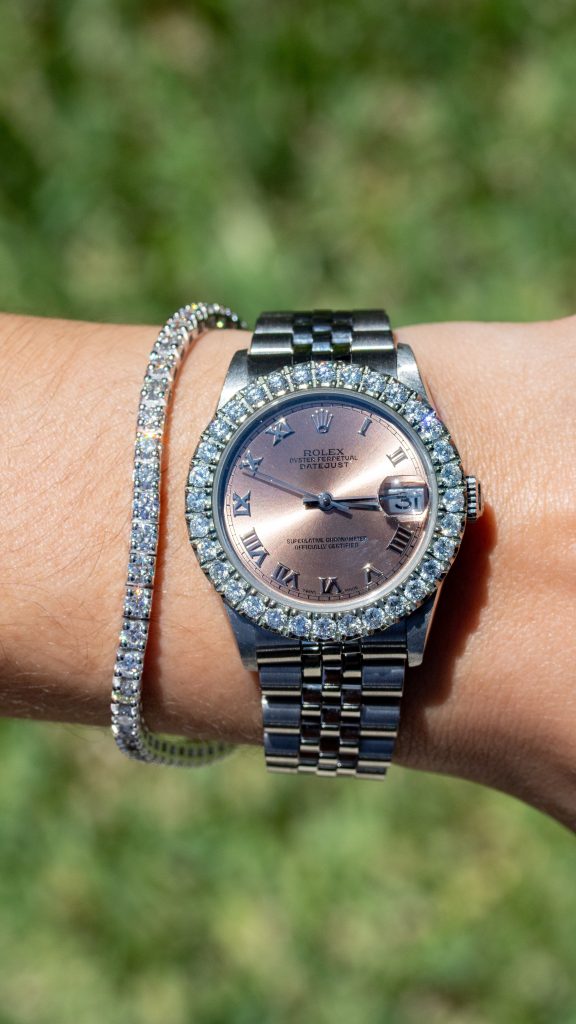
This Luxury Steel Rolex Watch was introduced first in 1945 as a way to commemorate the company’s 40th anniversary. It was the first chronometer wristwatch in the world to display the date through a window on the dial. Rolex’s best-selling model and most diverse collection. All these were judged in terms of metal, size, and bracelet, dial, and bezel choices is the Datejust. The Datejust is available in a variety of case sizes, including 26mm, 28mm, 31mm, 36mm, and 41mm. The bezel variations range from smooth to fluted to gem-set. The metal possibilities include steel, gold, a combination of steel and gold, and certain platinum variants of the Lady-Datejust.
One of the Datejust watches’ features is that its date window is quick; at midnight, the date moves to the following day rather than a gradual shift over a few hours. All Datejust watches, with the exception of certain very early versions from the 1940s and early 1950s, feature a magnifying lens above the date, formally known as the Cyclops. The Cyclops always bubbles over the crystal and magnifies the date 2.5 times.
Rolex GMT-Master & GMT-Master II
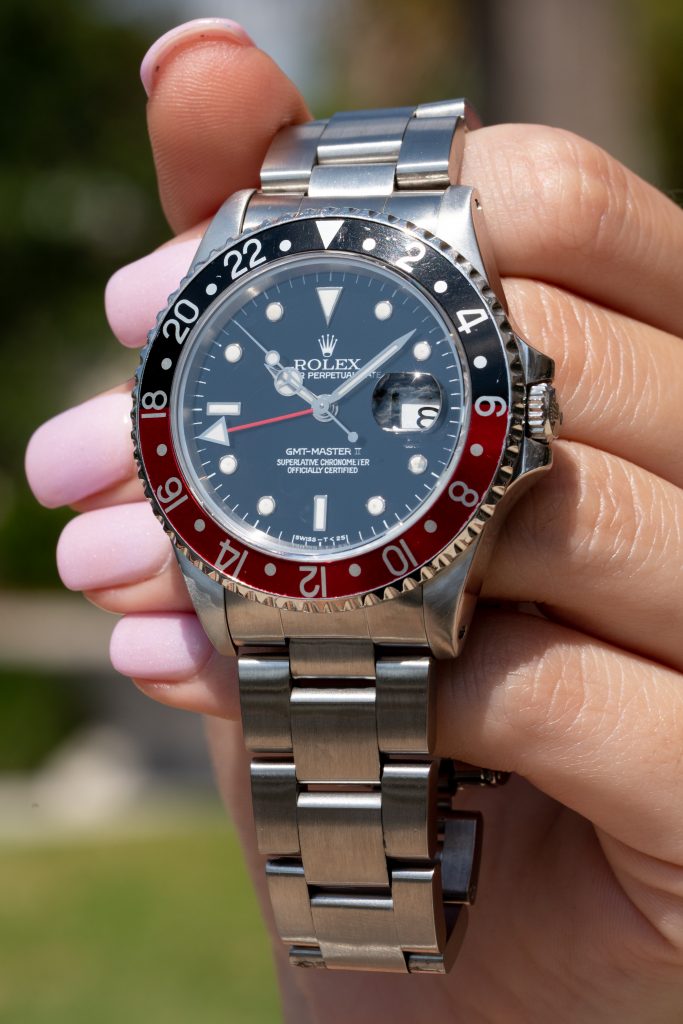
As commercial air travel was booming in the 1950s, Pan Am Airlines asked Rolex to create a watch that could monitor several time zones for its fleet of pilots. As a result, the Rolex GMT-Master watch was born. The watch was developed to assist pilots track both Greenwich Mean Time and local time. The GMT-Master dial had two hour hands, one standard 12-hour hand for local time and one 24-hour hand for reference time. To set the second time zone, the wearer adjusts the 24-hour bezel to correspond with the 24-hour hand.
It’s worth noting that the original GMT-Master reference included a bi-colored bezel for easy separation between day and night hours–a design element that’s still available today. Rolex released the GMT-Master II in the 1980s, which included a 24-hour hand that could be adjusted independently of the 12-hour hand. This meant the wearer could leave the bezel at zero and easily adjust the 24-hour hand to the right time. In the late 1990s, Rolex phased out the GMT-Master in favor of the GMT-Master II. All contemporary GMT-Master watches have Cerachrom bezels and are available in a range of metals and bezel colors.
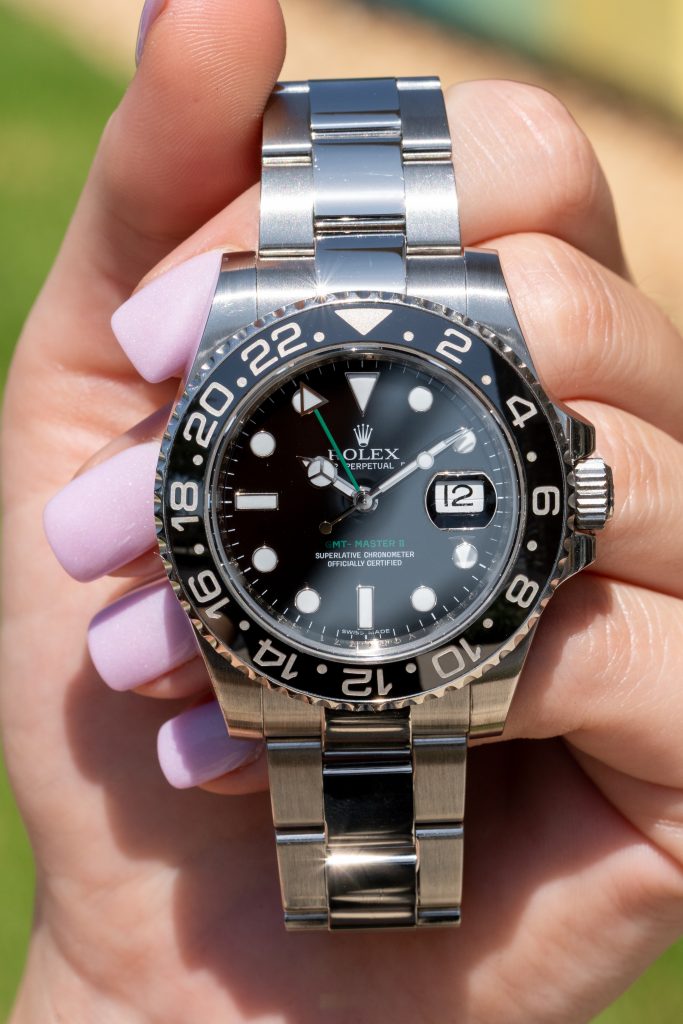
Rolex Milgauss
Rolex also released the antimagnetic Milgauss watch in 1956. The Milgauss, named after its ability to endure 1,000 gauss magnetic fields, was ideal for the era’s growing scientific and technical sectors. The lightning-bolt seconds hand on the time-only display was a distinguishing feature of early Rolex Milgauss watches. The ensuing Rolex Milgauss watch generation, nonetheless, did not have this eccentric design feature, and the line was finally phased out in the 1980s.
Nonetheless, Rolex reintroduced the Milgauss in 2007, not only reintroducing the lightning hand but also offering a special anniversary model with a green-tinted sapphire crystal. The Z-Blue Milgauss model launched in 2014, with an electric blue dial and green sapphire crystal–a model that is still in the collection today.
Rolex Cosmograph Daytona
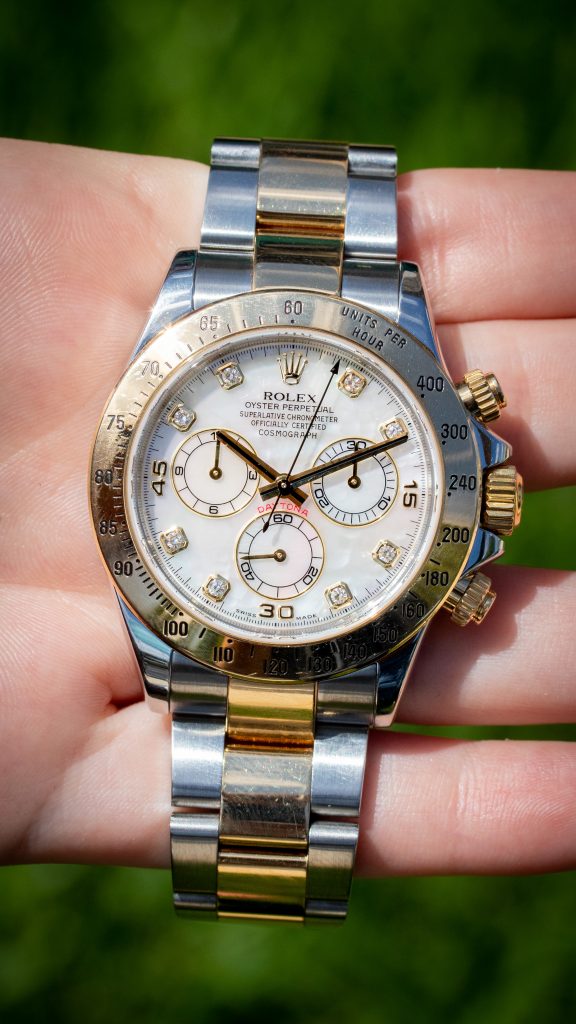
In 1963, Rolex introduced the Cosmograph chronograph line, which rapidly evolved into the Cosmograph Daytona to underscore the watch’s connection to the world of racing. The first version of the Daytona, which lasted until the late 1980s, featured manual-winding chronograph with tachymeter-marked bezels and displays with distinct subdials. Rolex Daytona chronographs were not popular at the time, but they are now among the most sought-after antique watches on the market. This is especially true of Daytona “Paul Newman” versions, which have Art Deco dials and are named after the famous actor who famously sold one.
In 1988, Rolex transformed the Daytona range into a collection of modern automated chronographs powered by Zenith El Primero-based movements. Unlike the preceding version, this one was an instant success, establishing the Rolex Daytona as the must-have luxury chronograph. Rolex updated the Daytona once more in 2000, this time with an in-house automated mechanism. The design of this Luxury Steel Rolex Watch remained essentially unchanged, and the Daytonas popularity remained. Rolex began outfitting certain Daytona models with Cerachrom ceramic bezels in the mid-2000s.
Rolex Yacht-Master

This incredible brand introduced the Yacht-Master in 1992 as an ultra-luxurious sports watch for men made entirely of 18k yellow gold, with a revolving timing bezel and a luminous time and date display. Women’s variants were soon introduced, as were two-toned steel/yellow gold and steel/platinum versions. Rolesium refers to the steel and platinum Rolex Yacht-Master watches, which are among the most popular models in the collection.
Rolex introduced Everose gold Yacht-Master watches with black Cerachrom ceramic bezels in 2015, as well as a whole new bracelet type known as the Oysterflex, which blends a metal inner blade with a black rubber covering. The next year saw the introduction of two-tone steel and Everose gold Yacht-Master versions. In recent years, a bigger 42mm Yacht-Master in white gold has been added to the line. The Yacht-Master series is the most diverse Rolex sports watch collection to date, thanks to the variety of sizes and steel available.
Rolex Yacht-Master II
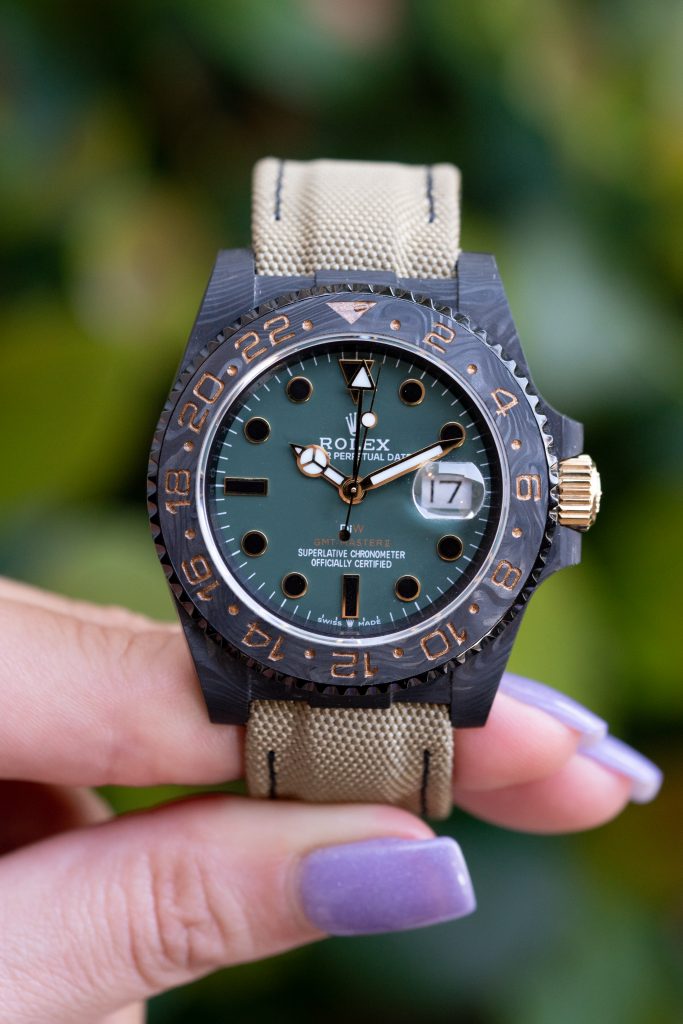
Rolex introduced the Yacht-Master II, the second chapter in the Yacht-Master narrative, in 2007. The Rolex Yacht-Master II, unlike its predecessor, is a complex watch featuring a regatta flyback chronograph, a programmable countdown timer, and mechanical memory. Furthermore, the bezel is known as a Ring Command Bezel since spinning it triggers which watch function to set.
The Yacht-Master II is not just one of Rolex’s most complicated watches, but it’s also one of the largest and most daringly designed, with a 44mm case, blue Cerachrom ceramic bezel, and a striking dial arrangement. The Yacht-Master II comes in steel, two-tone steel and gold, and complete gold finishes.
Rolex Sky-Dweller
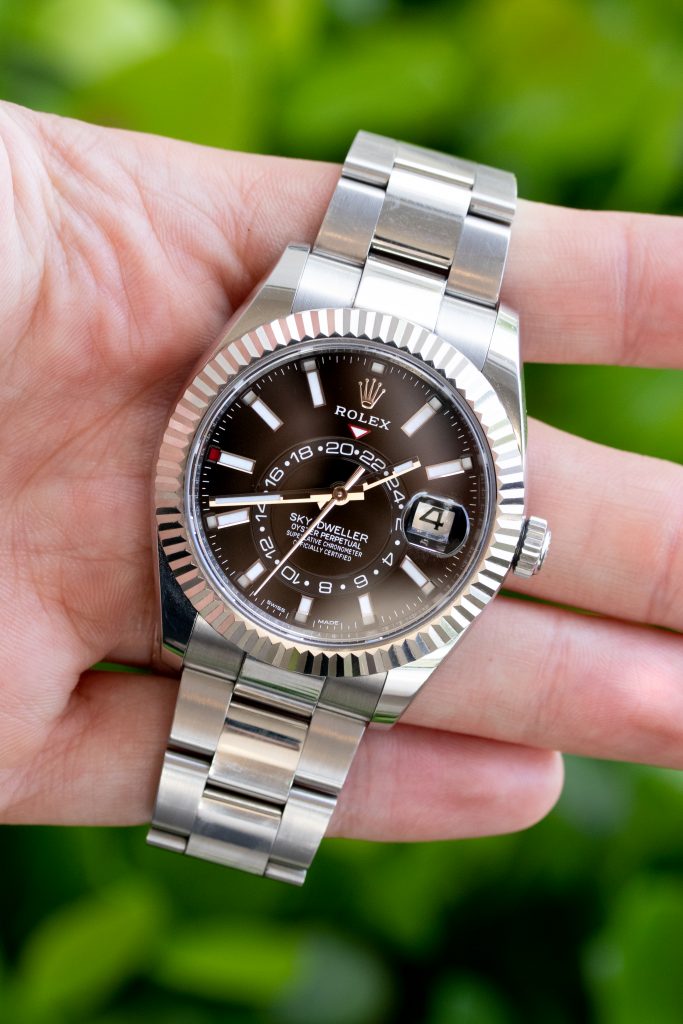
The Sky-Dweller is the newest Luxury Steel Rolex Watch model and the company’s first yearly calendar wristwatch, debuted in 2012. The Sky-Dweller is available in three gold colors: two-tone yellow gold and steel, steel with a white gold bezel, and steel with a white gold bezel. It has a 42mm case with a fluted bezel. This Rolex watch combines eye-catching design with intricate mechanisms. First, because the movement can distinguish between months with 30 and 31 days, the date window and apertures adjacent to the hour markers to show the current month automatically adapt throughout most of the year.
Due to the 28 or 29 days in February, the only time the wearer must manually change the calendar windows is on March 1st. In addition, the Sky-Dweller has a second time zone shown on the dial through an off-centered 24-hour disc. The Sky-Dweller is the perfect traveler’s watch thanks to its GMT capability and yearly calendar mechanism.
Rolex Explorer I
Rolex introduced the Explorer watch in 1953 to commemorate man’s first documented trip to the peak of Mount Everest. The then-new Rolex Explorer was based on the Oyster Perpetual watches given to the historic expedition’s crew members, but it also had its unique set of design features, many of which have remained intact over seven decades later.
The Explorer has always been a time-only Luxury Steel Rolex Watch with a black dial, Arabic numerals at 3, 6, and 9, and paired with an Oyster band, making it one of the most recognized Rolex watch models ever manufactured. The Explorer had a 36mm case for the majority of its lifetime, but since 2010, it has had a 39mm case.
Rolex Explorer II
Nearly 20 years after the Explorer was introduced for adventurers and mountain explorers, Rolex produced the Explorer II in 1971 for spelunkers and polar explorers. However unlike the original time-only Explorer, the first Explorer II included a date window as well as a fixed bezel marked to 24 hours and an additional 24-hour hand on the black dial. As a result, the first Rolex Explorer II was created as a Luxury Steel Rolex Watch with an A.M. /P.M. indicator for travelers who spend time in locations with erratic day/night cycles.
Meanwhile, Rolex improved the second generation Explorer II watch by adding an independent 24-hour hand, converting it to a dual time/GMT watch. There was also the option of a black or white dial. The Explorer II is still a GMT watch today; however it has a bigger case, is only available in stainless steel, and comes with a white or black face.
Conclusion
The Luxury Steel Rolex Watch catalog is replete with iconic watches that have become almost as famous as the legendary Crown that graces their dials, from the pared-down Explorer and Oyster Perpetual to the classic Datejust and Day-Date to the famed Submariner and GMT-Master to the complex Yacht-Master II and Sky-Dweller. Simply put, no other watch brand comes close to Rolex’s collection of award-winning timepieces. Whether you’re new to the Rolex club or a seasoned collector with an amazing collection of models, purchasing a Rolex watch is a special event to be cherished.

